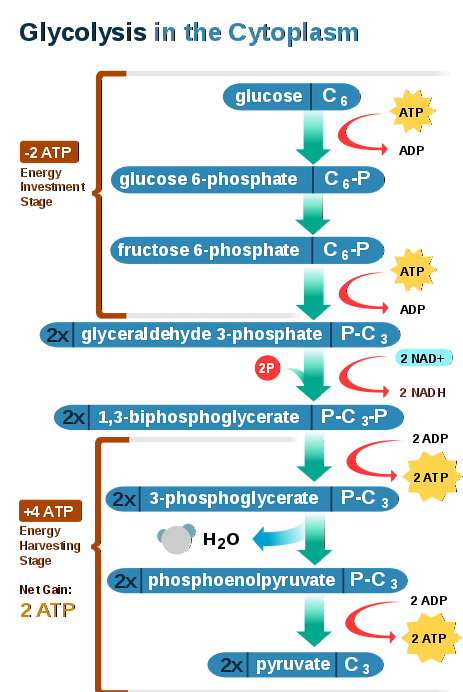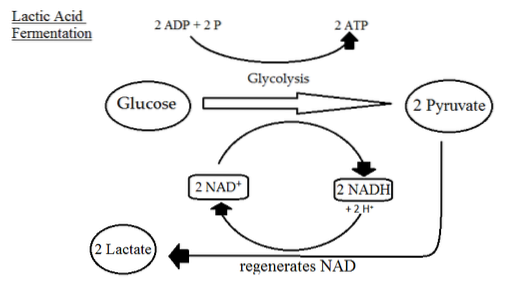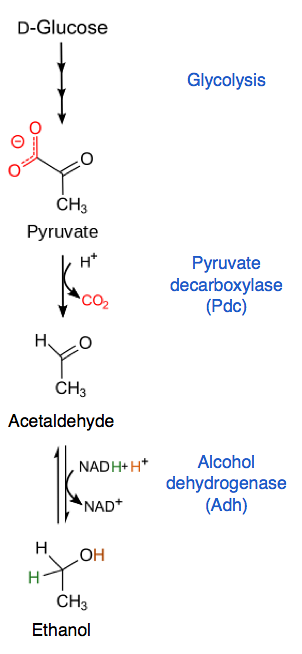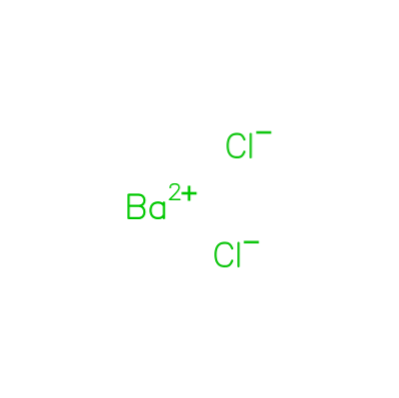
Anaerobic glycolysis reactions and fermentation pathways
The anaerobic glycolysis or anaerobic is a catabolic pathway used by many types of cells for the breakdown of glucose in the absence of oxygen. That is, glucose is not completely oxidized to carbon dioxide and water, as is the case with aerobic glycolysis, but fermentative products are generated..
It is called anaerobic glycolysis since it takes place without the presence of oxygen, which in other cases functions as the final electron acceptor in the mitochondrial transport chain, where large amounts of energy are produced from the processing of glycolytic products.

Depending on the organism, a condition of anaerobiosis or absence of oxygen will result in the production of lactic acid (muscle cells, for example) or ethanol (yeast), from the pyruvate generated by the catabolism of glucose.
As a result, energy yield drops dramatically, since only two moles of ATP are produced for every mole of glucose that is processed, compared to the 8 moles that can be obtained during aerobic glycolysis (only in the glycolytic phase)..
The difference in the number of ATP molecules has to do with the reoxidation of NADH, which does not generate additional ATP, contrary to what happens in aerobic glycolysis, where 3 ATP molecules are obtained for each NADH.
Article index
- 1 Reactions
- 2 Fermentation routes
- 2.1 Lactic acid production
- 2.2 Ethanol production
- 3 Aerobic fermentation
- 4 Glycolysis and Cancer
- 5 References
Reactions
Anaerobic glycolysis is not at all different from aerobic glycolysis, since the term “anaerobic” refers rather to what happens after the glycolytic pathway, that is, to the fate of the reaction products and intermediates..
Thus, ten different enzymes are involved in anaerobic glycolysis reactions, namely:
1-Hexokinase (HK): uses one ATP molecule for each glucose molecule. It produces glucose 6-phosphate (G6P) and ADP. The reaction is irreversible and requires magnesium ions.
2-Phosphoglucose isomerase (PGI): isomerizes G6P to fructose 6-phosphate (F6P).
3-Phosphofructokinase (PFK): phosphorylates F6P to fructose 1,6-bisphosphate (F1,6-BP) using one ATP molecule for each F6P, this reaction is also irreversible.
4-Aldolase: cleaves the F1,6-BP molecule and produces glyceraldehyde 3-phosphate (GAP) and dihydroxyacetone phosphate (DHAP).
5-Triose phosphate isomerase (TIM): participates in the interconversion of DHAP and GAP.
6-Glyceraldehyde 3-phosphate dehydrogenase (GAPDH): uses two molecules of NAD+ and 2 molecules of inorganic phosphate (Pi) to phosphorylate GAP, yields 1,3-bisphosphoglycerate (1,3-BPG) and 2 NADH.
7-Phosphoglycerate kinase (PGK): produces two ATP molecules by phosphorylation at the substrate level of two ADP molecules. It uses as a phosphate group donor each 1,3-BPG molecule. Produces 2 molecules of 3-phosphoglycerate (3PG).
8-Phosphoglycerate mutase (PGM): rearranges the 3PG molecule to produce an intermediate with higher energy, 2PG.
9-Enolase: from 2PG produces phosphoenolpyruvate (PEP) by dehydration of the first.
10-Pyruvate kinase (PYK): phosphoenolpyruvate is used by this enzyme to form pyruvate. The reaction involves the transfer of the phosphate group at position 2 of phosphoenolpyruvate to an ADP molecule. 2 pyruvates and 2 ATP are produced for each glucose.
Fermentation pathways
Fermentation is the term used to indicate that glucose or other nutrients are degraded in the absence of oxygen, in order to obtain energy.
In the absence of oxygen, the electron transport chain does not have a final acceptor and therefore oxidative phosphorylation does not occur, yielding large amounts of energy in the form of ATP. NADH is not reoxidized by the mitochondrial route but by alternative routes, which do not produce ATP.
Not enough NAD+ the glycolytic pathway is stopped, since the transfer of phosphate to GAP requires a concomitant reduction of this cofactor.
Some cells have alternative mechanisms to cope with periods of anaerobiosis, and generally these mechanisms involve some type of fermentation. Other cells, on the other hand, depend almost exclusively on fermentative processes for their subsistence..
The products of the fermentation pathways of many organisms are economically relevant to man; Examples are the production of ethanol by some anaerobic yeasts and the formation of lactic acid by the lacto-bacteria used for the production of yogurt..
Lactic acid production
Many types of cells in the absence of oxygen produce lactic acid thanks to the reaction catalyzed by the lactate dehydrogenase complex, which uses the carbons of pyruvate and the NADH produced in the GAPDH reaction.

Ethanol production
Pyruvate is converted to acetaldehyde and CO2 by pyruvate decarboxylase. Acetaldehyde is then used by alcohol dehydrogenase, which reduces it by producing ethanol and regenerating a molecule of NAD.+ for each pyruvate molecule that enters this way.

Aerobic fermentation
Anaerobic glycolysis has as its main characteristic the fact that the final products do not correspond to COtwo and water, as in the case of aerobic glycolysis. Instead, typical products of fermentation reactions are generated.
Some authors have described a process of "aerobic fermentation" or aerobic glycolysis of glucose for certain organisms, among which some parasites of the Trypanosomatidae family and many cancer tumor cells stand out..
In these organisms it has been shown that even in the presence of oxygen, the products of the glycolytic pathway correspond to products of fermentation pathways, so it is thought that a “partial” oxidation of glucose occurs, since not all the energy is extracted possible of its carbons.
Although the "aerobic fermentation" of glucose does not imply the total absence of respiratory activity, since it is not an all or nothing process. However, the literature indicates the excretion of products such as pyruvate, lactate, succinate, malate and other organic acids..
Glycolysis and cancer
Many cancer cells show an increase in glucose uptake and glycolytic flow.
Tumors in cancer patients grow rapidly, so the blood vessels are hypoxic. Thus, the energy supplement of these cells depends mainly on anaerobic glycolysis..
However, this phenomenon is aided by a hypoxia-inducible transcription factor (HIF), which increases the expression of glycolytic enzymes and glucose transporters in the membrane through complex mechanisms..
References
- Akram, M. (2013). Mini-review on Glycolysis and Cancer. J. Canc. Educ., 28, 454-457.
- Bustamante, E., & Pedersen, P. (1977). High aerobic glycolysis of rat hepatoma cells in culture: Role of mitochondrial hexokinase. Proc. Natl. Acad. Sci., 74(9), 3735-3739.
- Cazzulo, J. J. (1992). Aerobic fermentation of glucose by trypanosomatids. The FASEB Journal, 6, 3153-3161.
- Jones, W., & Bianchi, K. (2015). Aerobic glycolysis: beyond proliferation. Frontiers in Immunology, 6, 1-5.
- Li, X., Gu, J., & Zhou, Q. (2015). Review of aerobic glycolysis and its key enzymes - new targets for lung cancer therapy. Thoracic Cancer, 6, 17-24.
- Maris, A. J. A. Van, Abbott, Æ. D. A., Bellissimi, Æ. E., Brink, J. Van Den, Kuyper, Æ. M., Luttik, Æ. M. A. H., Pronk, J. T. (2006). Alcoholic fermentation of carbon sources in biomass hydrolysates by Saccharomyces cerevisiae: current status. Antonie van Leeuwenhoek, 90, 391-418.
- Nelson, D. L., & Cox, M. M. (2009). Lehninger Principles of Biochemistry. Omega editions (5th ed.).



Yet No Comments